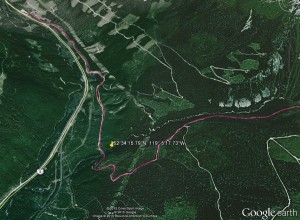By: Korie Marshall
Recent comments at Valemount Council and on social media discussion boards have locals wondering if access to a popular sledding area south of Valemount will be cut off while an independent power project is completed. The proponent says there’s an MOU in place with a local recreation association, but the association says the discussion has just started.
Sorgent.e, an Italian based energy company, is the new proponent of some run-of-river power projects in the North Thompson valley. One of them is located about 35 km south of Valemount on Clemina Creek, near a popular alpine sledding area that goes by the same name. The site is maintained by the Valemount & Area Recreation Development Association, and accessed in the winter via a parking lot along Highway 5 followed by a groomed 17 km trail that follows some existing forest service roads. The site of the powerhouse is just upstream from a bridge over Clemina Creek, about five kilometers up the trail from the parking lot.
Curtis Pawliuk, manager of VARDA, says he knows the powerhouse location well and there is already substantial development from when Canadian Hydro Developers was in the area. Canadian Hydro withdrew the project in 2009, and sold it and other projects to TransAlta. TransAlta completed the 19 megawatt facility at Bone Creek, just north of Blue River, before selling other partially completed projects to Sorgent.e. Pawliuk says he understands it’s the penstock and new transmission line that require the most work now.
Lucas de Haro, managing director of Sorgent.e General Services Ltd., says the former developer started construction on the project as well as improvements and extensions of the forest service road.
“Every time there is an overlapping of tenure there is a referral process; the parties have to agree on how to share those rights,” de Haro told the Goat. “And actually there is a memorandum of understanding that the previous developer had signed with VARDA and we have always considered it. So as far as I know there shouldn’t be any concern.”
Pawliuk says he’s unsure of the status of the old MOU, and VARDA’s discussions with Sorgent.e really just began last week.
“Unfortunately MOU’s are not binding but we hope to work out something that can work for all involved and keep our winter industry operating over the two year span,” said Pawliuk. “We look forward to working cooperatively with them.”
De Haro says the project requires a $30-$40 million investment and will be big for the valley.
“The construction is busy – we are talking about jobs for 200 people, it means there will be busy activity around the creek,” says de Haro, though it’s not clear how much of that will affect Valemount. He says construction won’t start before the spring of 2016, but exactly when it starts still depends on the agreement to build the power line.
The Ministry of Forest, Lands and Natural Resource Operations is currently reviewing Sorgent.e’s application to construct a 22.2 km, 69 kilovolt interconnection line that will convey electricity from the project into BC Hydro’s grid. The line will connect to the grid through an interconnection facility at the Serpentine Creek hydro project, which Sorgent.e is also working on, about 20 kilometers further south of Clemina Creek.
“Of course there will be some shared use agreements we will need to find, because the access road will need to be shared, but not only with us,” says de Haro. “You might be aware that BC Timber Sales has put out a request for offers to log that whole area, and we will need to adapt to them as well as them to us. It’s a regular activity you see all over the province.”
The ministry confirmed that no logging activity including hauling will take place in the area between Dec. 15, 2015 and March 15, 2016, due to safety and access concerns. And according to regional staff with the ministry, there should be no access conflict between the proposed IPP and snowmobilers due to the seasonality of use and the existing snowmobile trail paralleling the forest service road.
Pawliuk says VARDA is thankful for the cooperation of BCTS, who had agreed to withhold logging operations on the current blocks for sale in the Clemina area during the winter season.
After construction, de Haro says the power plants will likely only mean one or two direct jobs, but studies show they create between five and 10 indirect jobs.
“There are water license fees, land tenure fees, and a long term agreement with Simpcw First Nation, so there is a cash flow that helps to create jobs,” says de Haro.





